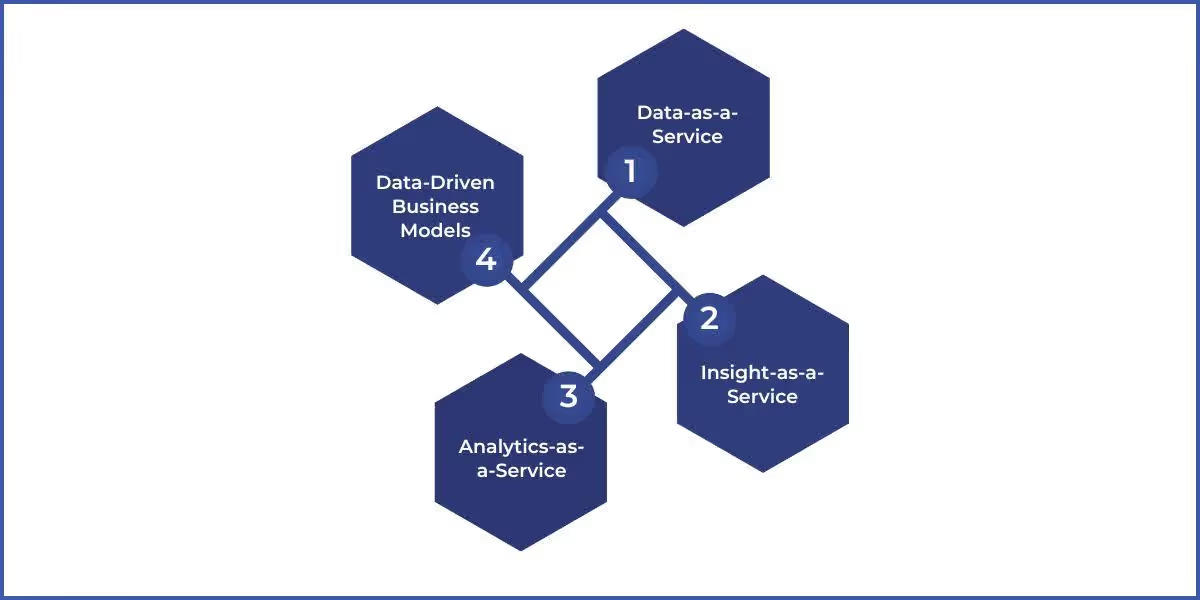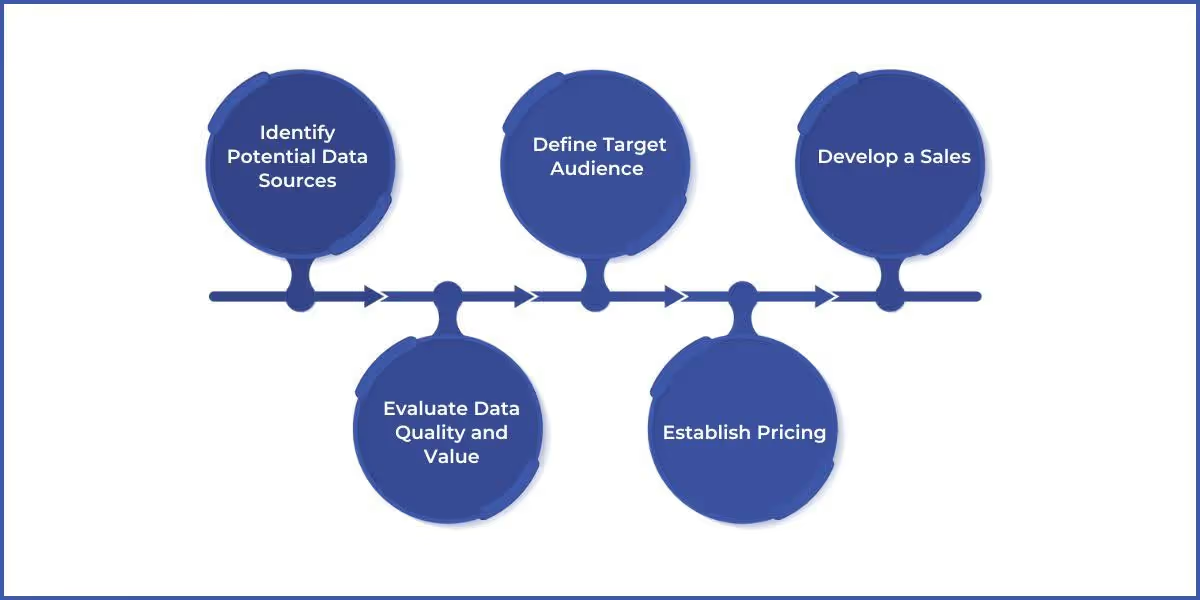

Businesses today are surrounded by data, customer preferences, sales trends, operational details—but most of it just sits there, unused. For decision-makers like CXOs and business leaders, the challenge is clear: how do we turn all this data into something valuable for our company?
The truth is, figuring out how to use data effectively can be tricky. Your competitors are already using their data to improve products, save money, and grow faster, which means doing nothing isn’t an option.
This guide is here to help you cut through the confusion. We’ll break down data monetization strategies into simple, practical steps. Whether in retail, manufacturing, financial services, or utilities, you’ll learn how to use your data to create measurable results.
Data monetization is the process of transforming a company’s data assets into direct or indirect economic value. It involves leveraging the data collected from various sources to create revenue-generating opportunities or operational efficiencies. Unlike general data utilization, data monetization focuses exclusively on converting data into measurable financial outcomes.
At its core, data monetization is about recognizing the economic potential of raw data and converting it into value—whether through direct revenue, operational efficiencies, or strategic partnerships. Organizations use this process to unlock hidden opportunities, extend their market reach, and enhance their overall competitiveness.
Key characteristics of data monetization include:
Exploring the tangible benefits of data monetization reveals its importance for driving long-term business success.
Data monetization is more than adding to the bottom line; it’s transforming how businesses operate and grow.
To fully capitalize on data’s potential, it’s essential to understand the different types of data monetization and how they work.
Monetizing data is a dynamic process with several pathways. Each strategy offers unique opportunities, from creating new revenue streams to enhancing business operations. The choice depends on how your data aligns with your business objectives. Below are some key types of data monetization.

This strategy involves providing raw, aggregated, or anonymized data to other businesses, typically in a direct business-to-business (B2B) model. DaaS requires minimal processing, as the data is often delivered as-is. Thus, the buyer is responsible for analyzing it using analytics or business intelligence (BI) tools.
This method is ideal for businesses lacking internal analytics resources but with valuable datasets, such as customer trends or environmental data. While it’s straightforward to implement, its revenue potential is lower since raw data needs further processing to deliver value.
DaaS is effective for organizations aiming to generate revenue while minimizing additional workloads. This method directly monetizes data and only needs basic data preparation.
Unlike DaaS, Insight-as-a-Service offers processed and actionable insights, such as market trends or customer behavior patterns. These insights often result from analyzing internal and external datasets, making them more valuable than raw data.
Businesses using this strategy typically provide reports, dashboards, or embedded analytics applications. The insights can be sold as one-time deliverables or subscriptions, creating recurring revenue opportunities.
This approach demands a deeper understanding of the buyer’s needs and requires organizations to invest in data analysis tools and expertise. As a result, the pricing is higher than DaaS due to the added value of actionable recommendations.
AaaS provides buyers with access to analytics platforms and tools, enabling them to explore and analyze data independently. Unlike IaaS, AaaS offers real-time access to advanced analytics, BI visualization tools, and sometimes predictive models operated by the data provider.
For instance, a market research company might allow buyers to interact with large-scale industry datasets through an intuitive analytics platform. This approach combines the benefits of providing both data and tools, offering a seamless user experience.
AaaS is the most IT-intensive strategy and requires robust infrastructure to ensure data security and performance. While it carries a higher operational burden, it has significant revenue potential, particularly for businesses with large, dynamic datasets.
This is an indirect monetization strategy that focuses on using data to improve internal processes, reduce costs, and enhance productivity. By leveraging operational and customer data, businesses can optimize decision-making across departments, such as sales, marketing, and supply chain management.
For example, a retail business may use sales data to estimate demand and manage inventory levels, reducing overstock and improving cash flow. Similarly, IT departments can analyze server logs to discover reoccurring problems, lowering downtime and increasing service efficiency.
This technique allows firms to generate value within rather than selling data externally, resulting in a sustainable paradigm for long-term growth.
Each monetisation type serves different goals, from driving internal efficiency to creating external revenue opportunities. Next, we’ll examine how businesses can effectively implement these strategies.
Successful monetization relies on aligning data strategies with business objectives. The following approaches can help businesses turn data into measurable value:
Data allows companies to identify inefficiencies, uncover opportunities, and make informed decisions. By analyzing real-time data, logistics companies can optimize delivery routes, saving fuel costs while improving delivery times. Retailers use sales data to forecast demand and adjust inventory levels, reducing waste and increasing profitability.
Collaborating with vendors or third parties can create mutual benefits. Retail chains often share sales and inventory data with suppliers to streamline restocking processes. This partnership reduces stockouts, enhances supply chain efficiency, and ensures timely customer deliveries.
Organizations can package their data or insights into valuable products for external businesses. Telecommunications providers sell network usage trends to advertisers to refine targeting strategies. Financial institutions analyze spending habits to develop consumer behavior insights for corporate clients.
Once you understand the approaches, the next step is building a solid foundation for data monetization.
Turning data into a revenue stream starts with a solid plan. This section outlines a straightforward approach to help businesses launch their data monetization strategies effectively, ensuring measurable results and sustained growth.

Your data estate is likely more expansive than you think. Begin by cataloging all available data sources across your organization, including customer interactions, operational records, and transactional data. Look for high-value datasets, such as behavioral trends or market insights, that could be monetized.
Data is only valuable if it’s accurate, consistent, and actionable. Assess the quality of your data by checking for gaps, redundancies, and accuracy issues. Additionally, evaluate its market value—ask whether it has insights that others would find beneficial.
Identify who will benefit most from your data. Are you targeting vendors, advertisers, or industry peers? Understanding your audience will help you choose the right monetization approach, such as direct sales or providing insights as a service.
Decide how much to charge and create clear usage policies. Pricing should reflect your data’s value and the effort required to maintain it. Governance policies should address data security, privacy compliance (e.g., GDPR, CCPA), and ethical usage guidelines.
Monetizing data isn’t just about creating value—it’s about selling it effectively. Build a sales and marketing plan that highlights the unique benefits of your data. Focus on channels that resonate with your target audience, such as industry conferences or digital campaigns.
Starting with these foundational steps ensures your business is ready to monetize data effectively. Next, explore how to prepare your organization for long-term success in data monetization.
Without a solid basis, even the most important datasets may remain untouched. Businesses can allocate resources and establish procedures to convert unprocessed data into quantifiable income. This section focuses on the critical steps to transform raw data into valuable assets that drive revenue.
Data is one of the most valuable assets for any business—but its true power lies in how well it’s managed. Metadata, which describes and categorizes your data, is critical in making your datasets usable and accessible. Think of Metadata as a digital index that helps your team quickly locate, understand, and utilize the data they need. Even the most valuable datasets can become overwhelming and underutilized without proper metadata organization.
Establishing distinct categories, such as the data’s source, purpose, and relevance, is the first step in efficiently managing metadata. Automation solutions help streamline this procedure through uniform data tagging and organization. Setting explicit principles and routinely assessing and upgrading your metadata structure to ensure it stays correct and in line with business requirements are also essential for success.
As businesses grow, their data needs evolve. A fragmented data storage or analysis approach can lead to inefficiencies, so building a centralized infrastructure is essential. A modern data infrastructure includes scalable storage solutions, secure access points, and analytics platforms that can handle large and diverse datasets.
For many businesses, cloud-based systems offer flexibility and cost-effectiveness. They allow you to scale storage and computing power as your data grows without requiring significant upfront investment. Regular infrastructure assessments ensure your tools align with your data monetization strategies.
Not all data is equally valuable to every audience. The key to successful data monetization is knowing who will benefit most from your data. This means identifying industries, businesses, or departments that can use your insights to solve specific problems. For instance, customer behavior data might be useful to advertisers, while operational metrics could help vendors streamline processes.
Defining clear buyer personas and target markets ensures that your data offerings resonate. Collaboration with sales and marketing teams can also uncover untapped opportunities.
Once your foundation is in place, the next step is exploring how collaborative sharing can amplify the value of your data.
Data sharing is a collaborative effort. Businesses can increase the value of their data by working with partners or vendors, which promotes growth and operational efficiency for both parties.
When businesses share data with their vendors, it creates an environment of trust and collaboration. For example, a retail company sharing real-time sales data allows suppliers to anticipate inventory needs. Vendors can align their production schedules to match demand, ensuring products are always in stock when customers need them.
This alignment doesn’t just benefit vendors—it reduces inefficiencies across the supply chain, prevents overstocking, and minimizes lost sales due to stockouts. As a result, both the business and its vendors see improved operational outcomes.
Accurate forecasting and shared data are essential for successful merchandising. Businesses and their partners can better estimate demand by examining seasonal trends and client preferences. Suppliers can adjust their production schedules to meet these projections, avoiding wasted resources and preventing shortages.
For instance, a retail company sharing holiday sales data enables vendors to prepare for peak shopping seasons, ensuring products are delivered on time and in the right quantities. This proactive approach not only boosts profitability but also enhances the customer experience.
Data is more than just information—it’s a valuable asset that can redefine your business. By recognizing its potential, you can unlock opportunities to drive smarter decisions, streamline operations, and generate new revenue streams.
However, monetizing data effectively requires a strategic approach. From identifying unique opportunities to building the infrastructure needed to deliver value, success comes from aligning these efforts with your business goals. With the right guidance, your data can become a powerful growth and competitive advantage driver.
At WaferWire, we specialize in helping businesses transform raw data into measurable success. Our tailored data monetization strategies align with your objectives, ensuring you achieve tangible results. Ready to unlock the full potential of your data? Contact us today and take the first step toward building a smarter, data-driven future.

